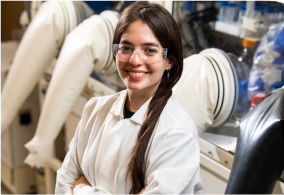
Frances Zengotita is a fourth-year graduate student in the Department of Civil and Environmental Engineering and Earth Sciences (CEEES). Frances was admitted to doctoral candidacy in the spring semester, and her research is focused on the influence of iron oxide nanoparticle crystallite size and surface defects on the sorption and reduction of plutonium. Professor Amy Hixon and Professor Kyle Doudrick, both in CEEES, serve as her advisor and MSE interdisciplinary mentor, respectively. Among her accomplishments, Frances is a 2020 GEM Associate Fellow and 2020 Nuclear Energy University Fellow.
Please briefly explain your research.
My research investigates the influence of iron oxide nanoparticle crystallite size on the sorption behavior of Plutonium. Plutonium has a rich redox chemistry where it can exist in up to four oxidation states in solution under specific conditions. In oxic conditions, plutonium can be present as Pu(V) which is considered the most mobile oxidation state, while Pu(IV) is assumed to be the most immobile oxidation state. However, certain caveats exist such as nanoparticle-facilitated transport.
Mineral nanoparticles (i.e., iron oxide mineral nanoparticles) have been found to reduce plutonium from Pu(V/VI) to Pu(IV) at the surface and the mechanism for this reduction remains unclear. Current studies demonstrate that current risk assessment parameters did not predict kilometer-scale migration of plutonium associated with the colloidal fraction of inorganic material, such as mineral nanoparticles. Due to the potential transport of plutonium in the subsurface environment, my research investigates the sorption, desorption, and redox processes of Pu on the surface of hematite and magnetite nanoparticles under environmental conditions.
How did you become interested in this field?
In my undergraduate career, my research focused on (1) updating equilibrium sorption parameters for risk-driving actinides (i.e. plutonium and americium) via oxidation state analogs (i.e. neodymium, europium), (2) understanding the role of ionic strength on the sorption processes of these radionuclides, (3) the role of ligands and microbes on the potential mobilization of these contaminants and (4) the migration of plutonium from estuary sediments in the United Kingdom.
My undergraduate research solidified what I would like to pursue in graduate school - investigate the fate and transport of radionuclides under environmental conditions to update current performance assessment models at deep geological repositories. So, when I decided to pursue graduate school, I found that Dr. Amy Hixon (my advisor) conducted environmental research with plutonium, and that had me instantly connected with actinide geochemistry. What kept me actively engaged in this research topic was learning about the size-dependent effects that occur with my iron oxide nanoparticles with decreasing crystallite sizes. Size-dependent effects are endlessly fascinating and continue to challenge me every day.
For the non-technical audience, how does your materials research impact our daily lives?
Although nuclear energy is a reliable option for a green future, it still creates radioactive waste products. Plutonium can be found in the environment due to nuclear weapon testing, nuclear accidents, and nuclear waste disposal. Plutonium has high radiological toxicity, and its isotopes have long half-lives (i.e., 239Pu t1/2 = 24,100 yrs) which pose a threat to the public. Therefore, it is important to understand the long-term behavior of nuclear materials in the environment to provide insight for long-term storage for repositories (for the permanent disposal of nuclear waste). The results of my research could be utilized in future performance assessment models for nuclear facilities, to develop new disposal strategies of nuclear waste, and support licensing procedures. The completion of this work will aid in the goal of advancing towards a safe, secure, and sustainable future.
How has your work with an interdisciplinary mentor, in your case Professor Doudrick, expanded your understanding of your field?
The valuable insight and direction I have received from my interdisciplinary mentor (Doudrick) has expanded my knowledge of nanoparticles and nanoscale reactions. I joined the program initially as a second year to expand my horizons as well as understand the results of my naturally engineered system. He provided useful advice on what experiments to pursue (i.e. surface area normalized experiments) and that would help answer some of the questions I have with my research. Further, we have had many conversations on my research that have led to me look at my results in a different light and make sense of it from an environmental engineering perspective. It was important to better understand the nature of my nanoparticles, so Dr. Doudrick led me in the right direction in understanding nanoscale reactions (i.e. chemical kinetics).
What is your favorite season to be on campus, and why?
My favorite season to be on campus is the fall semester, primarily because the changes from hot summer greenery to an orange wonderland full of fallen leaves are part of the mid-western experience. Coming from Miami, I did not experience four seasons as I do here at Notre Dame. Although I am not a fan of winter and snow, the beauty of Fall right before it makes up for it.